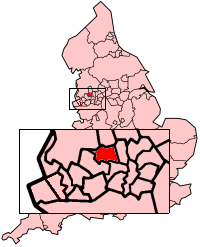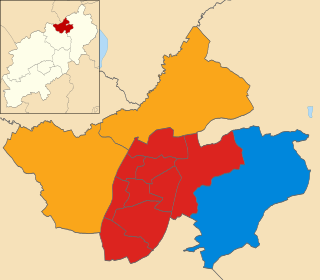The 1964 Southwark Council election took place on 7 May 1964 to elect members of Southwark London Borough Council in London, England. The whole council was up for election and the Labour party gained control of the council.
The 1986 Lambeth London Borough Council election took place on 8 May 1986. All 64 members of Lambeth London Borough Council were elected. The elections took place alongside local elections in the other London boroughs and elections to local authorities across the United Kingdom.
The 1964 Lambeth Council election took place on 7 May 1964 to elect members of Lambeth London Borough Council in London, England. The whole council was up for election and the Labour party gained control of the council. The election is notable for being the first one ever fought by John Major.
The 1964 Newham London Borough Council election took place on 7 May 1964 to elect members of Newham London Borough Council in London, England. The whole council was up for election and the Labour Party gained control of the council.
The 1964 Lewisham Council election took place on 7 May 1964 to elect members of Lewisham London Borough Council in London, England. The whole council was up for election and the Labour Party gained control of the council.

The first elections to Bolton Metropolitan Borough Council were held on Thursday, 10 May 1973, with the entirety of the 69 seat council - three seats for each of the 23 wards - up for vote. It was the first council election as the newly formed metropolitan borough under a new constitution. The Local Government Act 1972 stipulated that the elected members were to shadow and eventually take over from the County Borough of Bolton, the Municipal Borough of Farnworth, the Urban Districts of Blackrod, Horwich, Kearsley, Little Lever, and Westhoughton, and the southern part of Turton Urban District on 1 April 1974. The order in which the councillors were elected dictated their term serving, with third-place candidates serving two years and up for re-election in 1975, second-placed three years expiring in 1976 and 1st-placed five years until 1978.
The first election to the Bridgend County Borough Council was held on 4 May 1995. It was followed by the 1999 election. On the same day there were elections to the other 21 local authorities in Wales and community councils in Wales.

The 1976 Corby District Council election took place on 6 May 1976 to elect members of Corby District Council in Northamptonshire, England. This was on the same day as other local elections. It was the first election be held under new ward boundaries. The Conservative Party gained overall control of the council from the Labour Party, for the first and only time in its history.

The 1979 Corby District Council election took place on 3 May 1979 to elect members of Corby District Council in Northamptonshire, England. This was on the same day as other local elections. The Labour Party regained overall control of the council which it had lost to the Conservative Party at the previous election in 1976. The council has remained continuously under Labour control to this day.

The 1995 Corby District Council election took place on 4 May 1995 to elect members of Corby Borough Council in Northamptonshire, England. This was on the same day as other local elections. The Labour Party retained overall control of the council, which it had held continuously since 1979.
The 1973 Derby Borough Council election took place on 7 June 1973 to elect members of Derby Borough Council in England. This was on the same day as other local elections. Voting took place across 18 wards, each electing 3 Councillors. Following the Local Government Act 1972, this was the first election to the new non-metropolitan district council for Derby, which came into being on 1 April the following year. The Labour Party took control of the Council after winning a majority of seats.

The 1979 Derby City Council election took place on 3 May 1979 to elect members of Derby City Council in England. This was on the same day as other local elections. Voting took place across 18 wards, each electing 3 Councillors. The Labour Party gained control of the council from the Conservative Party.

The 1980 Derby City Council election took place on 1 May 1980 to elect members of Derby City Council in England. This was on the same day as other local elections. 14 of the council's 44 seats were up for election. The Labour Party retained control of the council.

The 1982 Derby City Council election took place on 6 May 1982 to elect members of Derby City Council in England. This was on the same day as other local elections. 15 of the council's 44 seats were up for election. The Labour Party retained control of the council.

The 1983 Derby City Council election took place on 5 May 1983 to elect members of Derby City Council in England. This was on the same day as other local elections. 15 of the council's 44 seats were up for election. The Labour Party retained control of the council.
The 1976 Ipswich Borough Council election was the second election to the Ipswich Borough Council which had been established by the Local Government Act 1972 in England and Wales. It took place as part of the 1976 United Kingdom local elections.
The 1979 Ipswich Borough Council election was the first election to the Ipswich Borough Council under the new arrangements determined by the Local Government Boundary Commission as laid out in their Report 280. In accordance with the Local Government Act 1972 the Council had request a system of electing by thirds. Originally the Council had argued for 18 wards with 3 councillors each, making 54 in total. However, when this was analysed in terms of the Suffolk County Council (SCC), this was more numerous than would be compatible with the SCC's desired size of 75 members. The Ipswich Borough Council was invited to submit a revised proposal, leading to the creation of 16 wards with 3 councillors each. This became the finalised structure of the wards for the 1979 election.
The 1980 Ipswich Borough Council election was the first election to the Ipswich Borough Council under the system of electing by thirds, whereby a third of the councillors were to stand for election, each time. These new arrangements had been determined by the Local Government Boundary Commission as laid out in their Report 280.
The 1980 Ipswich Borough Council election was the second election to the Ipswich Borough Council under the system of electing by thirds, whereby a third of the councillors were to stand for election, each time. These new arrangements had been determined by the Local Government Boundary Commission as laid out in their Report 280.
The 1983 Ipswich Borough Council election using the system of electing by thirds was completed as this was the third election to the Ipswich Borough Council under the arrangement, whereby a third of the councillors were to stand for election, each time. These new arrangements had been determined by the Local Government Boundary Commission as laid out in their Report 280.







